This post may contain affiliate links. We may receive a small commission, at no cost to you, if you make a purchase. Read Disclosure.
The Great Ocean Road is famous around the world as one of the best scenic drives on the planet.
The landscape is so scenic, that no one ever drives from one end to the other without stopping.
It would be sinful to do so. Some of the attractions along the way are so iconic, it would be like driving past the Grand Canyon and not stopping for a photo.
Beginning one hour outside of Melbourne in Torquay, The Great Ocean Road stretches over 250 kilometers to Allansford, a small town near Warrnambool.
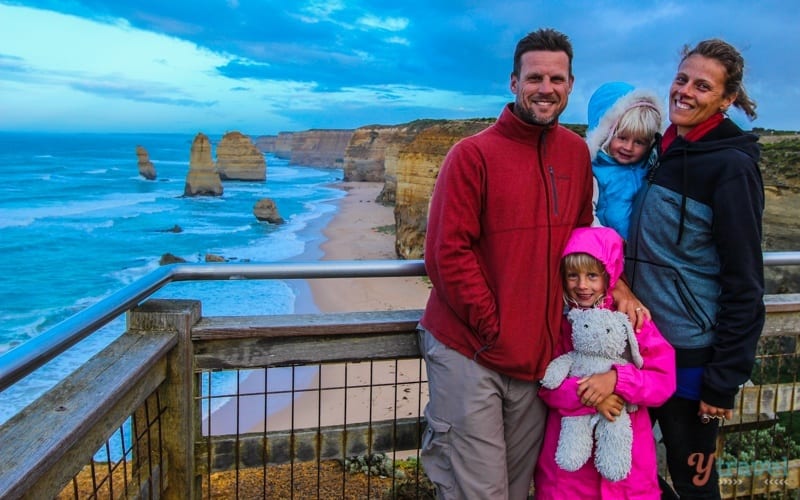
If you’re planning to complete a Great Ocean Road trip, but not sure what to see and do on the way, this guide is for you.
Below we share a Great Ocean Road itinerary which includes the top attractions in order from Torquay to Warrnambool.
How many days should I spend on the Great Ocean Road?
The Great Ocean Road Drive was high on our list of things to do in Victoria.
Whilst the tour buses routinely drive this in one day (which is crazy in my opinion) we had time on our side and we took two weeks to appreciate the region for what it’s worth.
We know most people don’t have the luxury of this amount of time, so we recommend you take two or three days to complete the Great Ocean Road.
The Great Ocean Road Itinerary
To help you plan your route, we’ve listed the most iconic attractions on the Great Ocean Road in order. The following itinerary can be stretched out or cut short, depending on the amount of time you have.
Use the following map to plan your journey. You can save this map to your device by clicking the star icon at the top.
Because most people take this scenic drive from Melbourne, we have begun this itinerary from Torquay and will end at the official end of Warrnambool, but you can easily do this route the other way.
Stop 1: Torquay
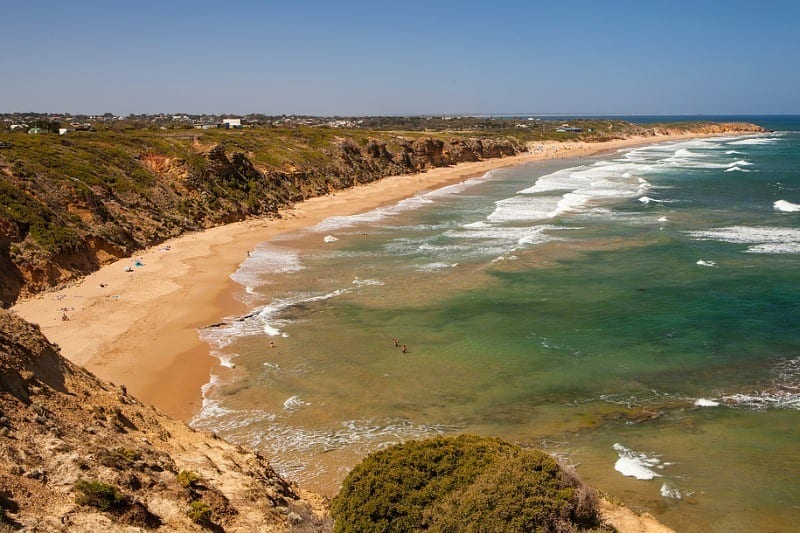
The official starting point of the Great Ocean Road is Torquay. However, even though it’s the gateway, it’s worth spending a day or two to explore this coastal destination.
It’s full of stunning natural beauty and has a laid-back vibe, and is well known as the birthplace of Australian surfing – yep, not the famous Bondi Beach!
It has iconic surf spots like Jan Juc Beach, and it also has some lovely scenic coastal walks, such as the Surf Coast Walk, for those who are not into surfing.
The town itself has a relaxed, beachy atmosphere with trendy cafes, boutique shops, and surf culture memorabilia. Visit the Australian National Surfing Museum if you have time and learn about the history of surfing in Aus.
Stop 2: Bells Beach
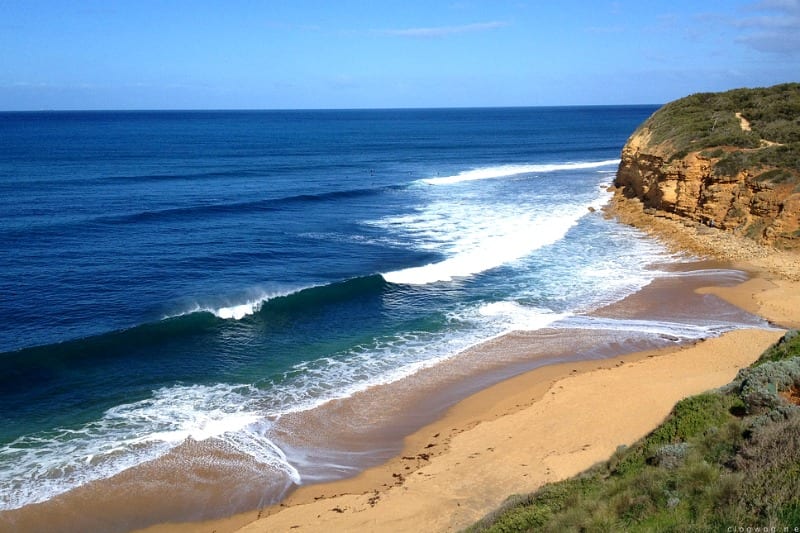
- Distance from last stop: 10.4 km
- Drive time: 12 minutes
Bells Beach is one of Australia’s most famous and best surfing beaches. It’s a must-see if you love amazing scenery.
It holds the annual Rip Curl Pro Surfing Competition, which is a powerful point break of folklore. Heard of the movie Point Break? That’s our Bells!
There’s an impressive cliff-face and views from the cliff-top car park are spectacular and a great spot to watch any local surfers.
All dedicated surfers want to get down to the Great Ocean Road to ride the same waves that the pros do at Bells.
Stop 3: Great Ocean Road Chocolaterie and Ice Creamery, Bellbrae
- Distance from last stop: 6.1 km
- Drive time: 6 mins
Come rain or shine, the Great Ocean Road Chocolaterie is always open.
But this is not just a place that sells chocolate and ice cream, they also run chocolatier workshops and classes for kids every now and then, which is definitely worth doing if you’re traveling with kids.
Sometimes it can be hard for kids to be sitting in a car for a long time, so make sure to take a stop by Bellbrae so the kids can take this yummy workshop.
And mom and dad can enjoy an ice cream and some quiet time while they wait.
Stop 4: Memorial Arch
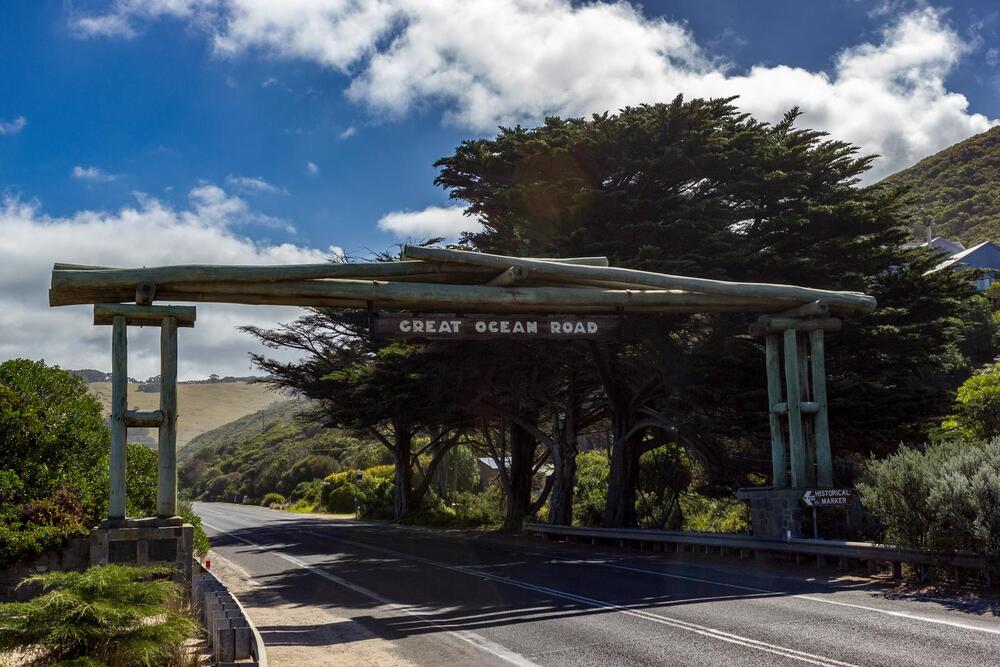
- Distance from last stop: 21 km
- Drive time: 20 minutes
The Memorial Arch is often missed because it’s located at the very start of the Great Ocean Road. The arch and the statue were built to commemorate the soldiers lost during WWI.
It was made from wood, with the sides made out of stone and cement.
The arch has been damaged many times since it was built in 1939, and was even considered to be removed in the 70s as the government feared it was a hazard to drivers.
Despite battling bushfires and stormy winds, the arch still stands tall today. This is a testament to the brave men the monument represents, who stood strong during the dark days of the war.
The sign on the arch is still the original from 1939.
Stop 5: Lorne
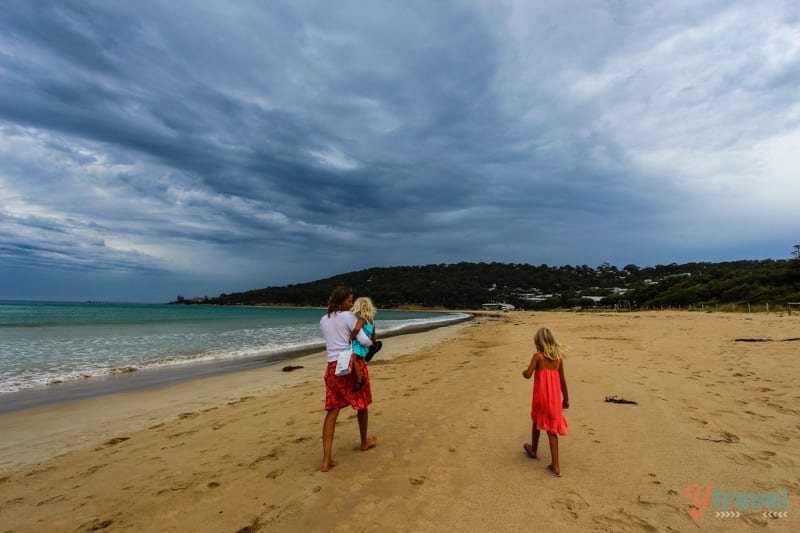
- Distance from last stop: 13 km
- Drive time: 16 minutes
Lorne is a picturesque town situated Great Ocean Road coast and was our favourite town to stay in along the journey.
It has a certain charm with plenty of things to do, including great cafes, unique shops boutiques, and galleries, and Otway National Park is on your doorstep. Take a trip over to see Erskine Falls, just a short drive out of the town centre.
Lorne is only 140 kilometres south of Melbourne and this place swells with people over the Christmas holidays.
Enjoy a walk on the beach, a bike ride along the foreshore out to the pier, have a coffee at HAH Lornebeach, right on the beach, and try a burger from The Bottle of Milk – delicious!
Stop 6: Teddy’s Lookout

- Distance from last stop: 2.3 km
- Drive time: 5 minutes
A short drive up the hill behind Lorne is Teddy’s Lookout. This is a viewpoint that offers expansive views of the coast and the winding road.
To get there, drive up to the picnic area at the end of George Street and walk a short distance to enjoy the spectacular views of the Great Ocean Road from the lookout.
There’s also a 45-minute walk you can do here.
The Lorne to Apollo Bay Drive
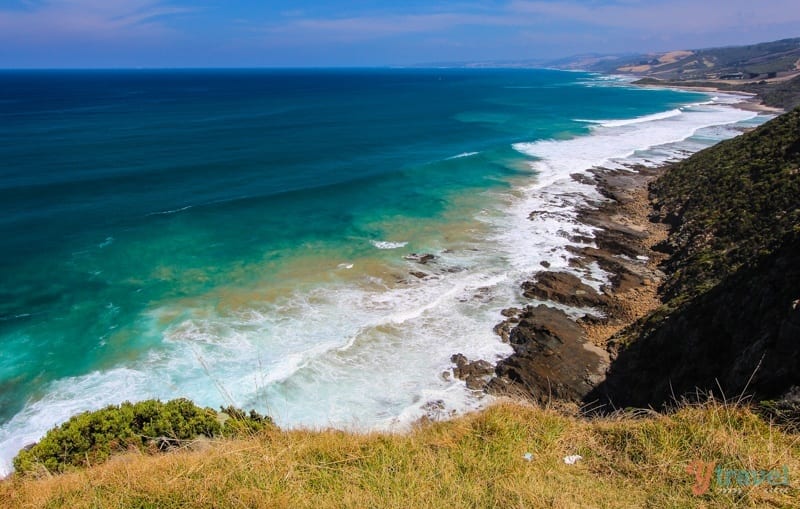
Our favourite stretch of road on our Great Ocean Road tour was from Lorne to Apollo Bay. Be prepared to stop for photos a lot.
This stretch of road has some of the most picturesque scenery in the region.
The Great Ocean Road hugs the cliff face as it winds through the Great Otway National Park and rolling farmland.
Stop 7: Kennett River Koala Walk
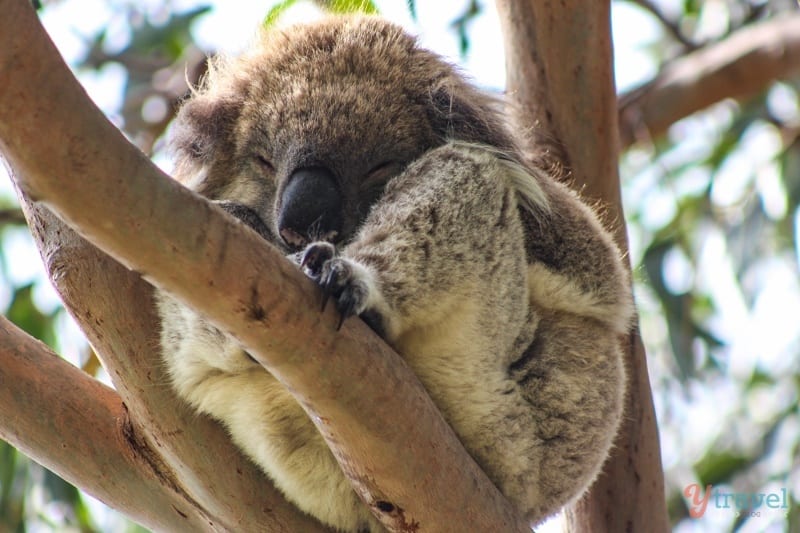
- Distance from last stop: 22.6 km
- Drive time: 30 minutes
Want to see koalas in the wild? The best koala-viewing spot is Kennet River, along Grey River Road, just in the middle of town.
Otway Lighthouse Road is another popular spot for wildlife wonders.
I never knew the Great Ocean Road was a place to spot wild koalas. Yet another great reason to visit the GOR.
It’s not that common to find koalas in the wild, let alone sleeping in trees by the side of the road or in the middle of town.
But this is the Great Ocean Road. Just look for the crowds of people and follow their gazes up for quick koala spotting.
Stop 8: Mariners Lookout – Apollo Bay
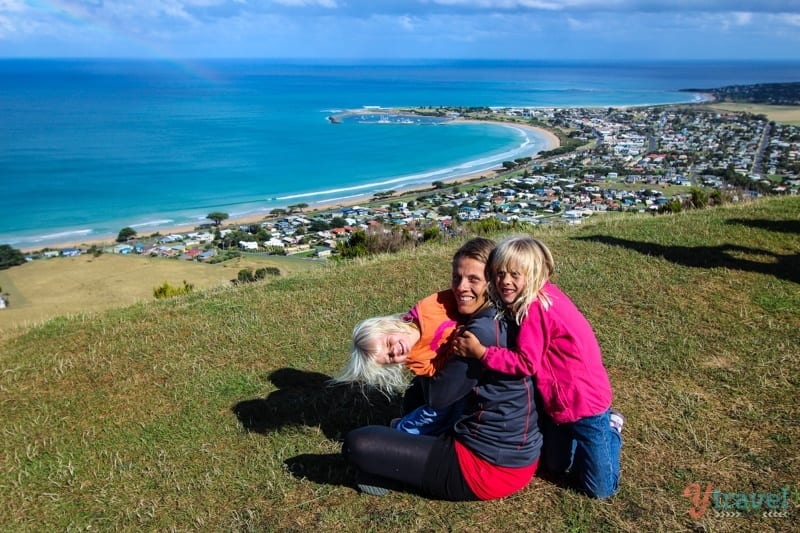
- Distance from last stop: 22.3 km
- Drive time: 25 minutes
Panoramic views of Apollo Bay’s town centre, the harbour, and beaches up and down the coast can be enjoyed from the Mariners Lookout, located at the northern end of town off Mariners Lookout Road.
Stop 9: Apollo Bay YHA Eco Hostel
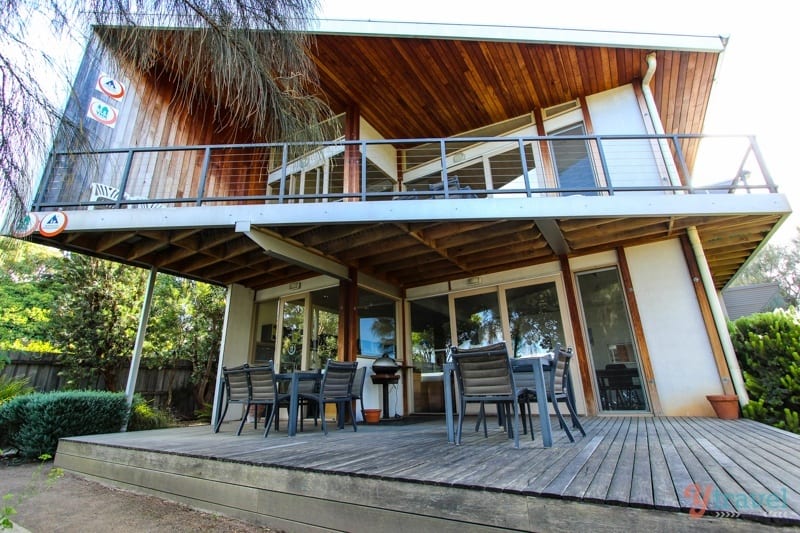
- Distance from last stop: 3.2 km
- Drive time: 6 minutes
Apollo Bay is perfectly positioned about halfway along the Great Ocean Road and surrounded by Otway National Park State Forest and rolling acres of green farmland.
Looking for an affordable and family-friendly place to stay? The Apollo Bay YHA Eco Hostel was a lovely place to base ourselves for a few days.
The hostel has a very homely vibe with great kitchen facilities, lounge rooms, and a rooftop deck to enjoy a sunrise.
This is not a party hostel, no YHA properties are, and we met a lot of nice families and solo travelers here. It’s a wonderful option for your Great Ocean Road accommodation.
Our family room consisted of a queen bed and bunk beds.
Stop 10: Shipwreck Coast (Cape Otway to Port Fairy)
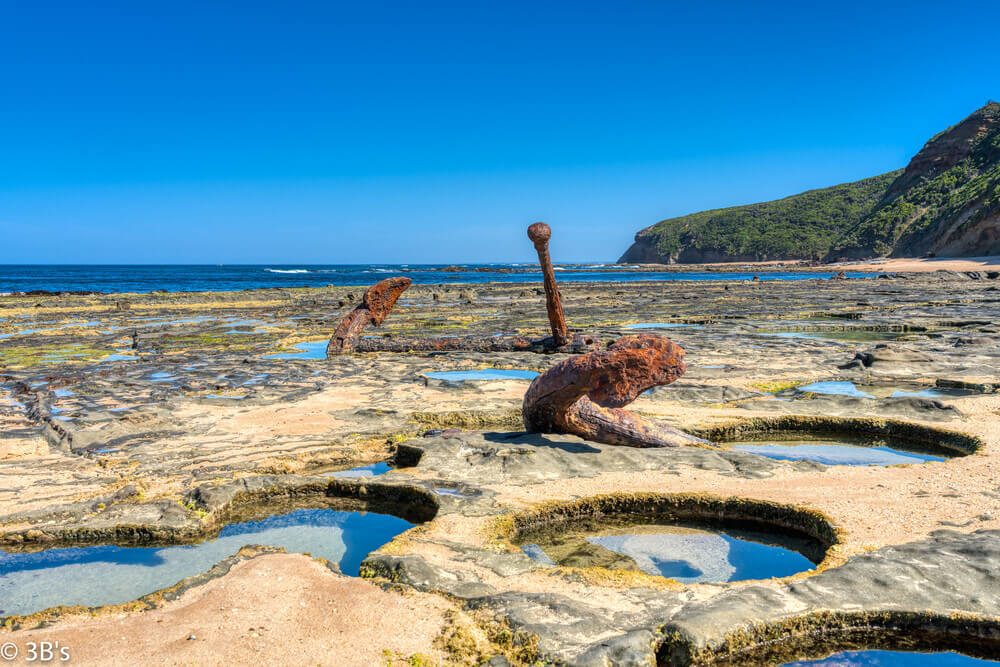
While the Great Ocean Road is safe to drive, there is a stretch of about 120 km that has an infamous past. But don’t worry, the dangers are further out into the ocean.
The stretch of road between Port Fairy to Cape Otway is known as the shipwreck coast, this is because of dangerous waters that have caused shipwrecks in the past.
In the 1700-1800s, these stormy waters were part of a popular trading route, but many boats ran into trouble when the sea was rough. Even Matthew Flinders, a famous explorer, was afraid of this coast.
It is estimated there are around 700 shipwrecks in the ocean, but only 240 have been discovered…so far.
The best place to see shipwrecks is from the aptly named, Wreck Beach, which has two anchors from wrecks on the beach, as well as Loch Ard, which is the most famous wreck on the coast.
It was here that survivors, Tom Pearce and Eva Carmichael, washed ashore and spent the night near the 12 Apostles.
A good place to see shipwrecks is by Cape Otway Lighthouse.
Stop 11: Triplet Falls – Otways National Park
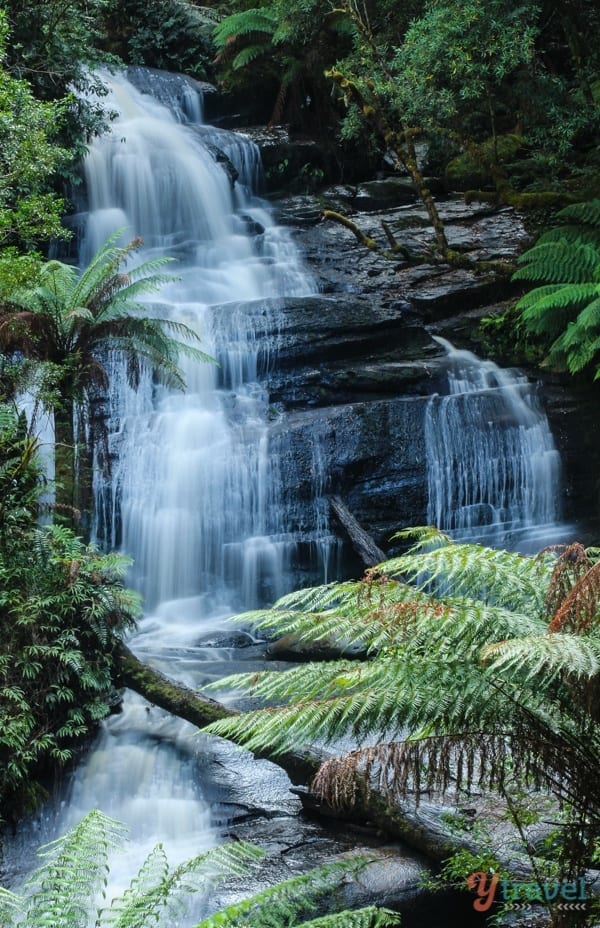
- Distance from last stop: 48 km
- Drive time: 1 hour
Head inland for a detour to the Otways National Park and immerse yourself in an ancient land.
Walk among tall trees and giant tree ferns, and discover beautiful waterfalls.
This is the spot on the Great Ocean Road to move away from the gorgeous coastline and into a forest perspective.
Triplet Falls is one of the highlights of the Great Ocean Road. Platforms provide you with spectacular views of falls. The walk is about a 1-hour return loop, which we did it easily with our kids.
If you like waterfalls, another stunning one to checkout in Otways National Park is Beauchamp Falls, but if you only have time for one, make it Triplet Falls.
Stop 13: Gibson Steps
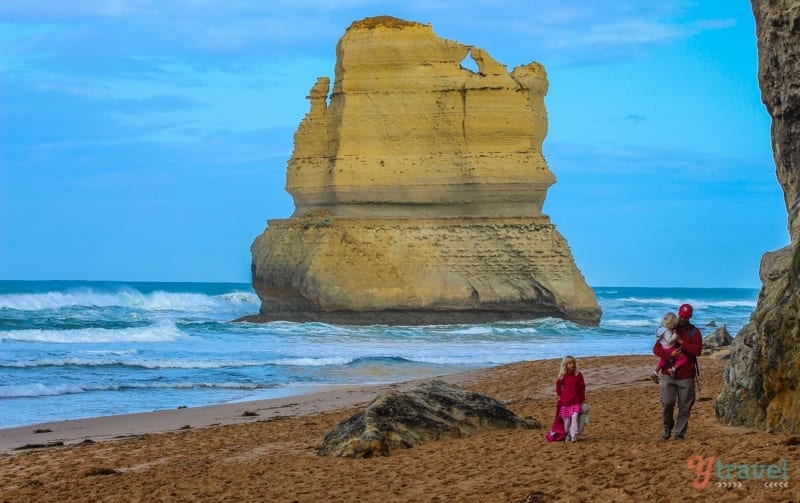
- Distance from last stop: 58 km
- Drive time: 1 hour
Just down the road from the Twelve Apostles Visitors Centre are the Gibson Steps. Walk down these steps to the beach for a close-up view.
Here you can experience a new perspective on the power of the waves and the height of the rocks. You can even touch the rocks and feel how easily they crumble away.
Take time to watch the water crashing around the base of the limestone stacks to understand the true power of the ocean and how it’s constantly shaping our earth.
Tip for the Gibson Steps: Keep the tide in mind. It was coming in quite fast on us, so don’t walk too far around the corner as you may have a wet walk back.
Stop 14: Walks in Port Campbell National Park
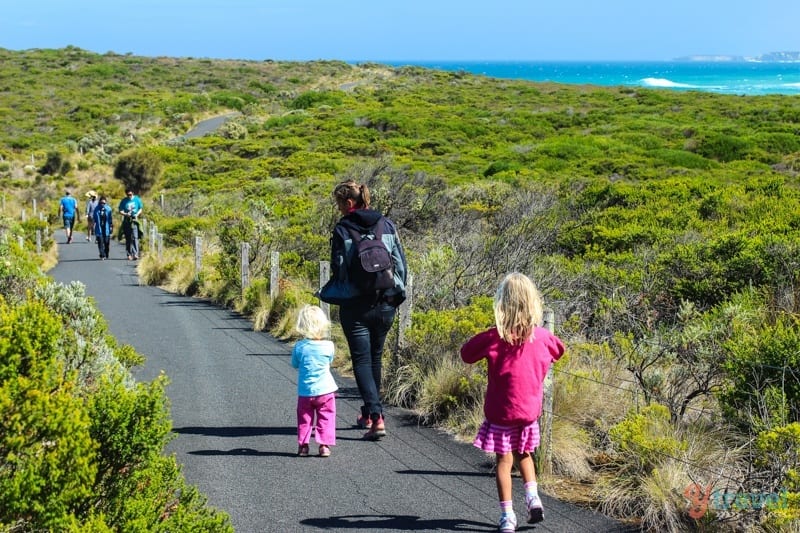
- Distance from last stop: 1.2 km
- Drive time: 3 minutes
Port Campbell National Park is not just about standing at the 12 Apostles and taking your “I was here pic“. We arrived thinking we’d spend a couple of hours looking at the rocks, but we ended up staying all day.
The park has so much to offer with cliff-top tracks, gorges, short walks on the beach, and tales of shipwrecks to discover. It’s truly a fascinating and beautiful park.
Don’t be like the Great Ocean Road tour-bus masses. Take your time and appreciate all the sites within the Port Campbell National Park: 12 Apostles, Gibson Steps, Loch Ard Gorge, London Arch, The Grotto, and The Arch.
Stop 15: The Twelve Apostles
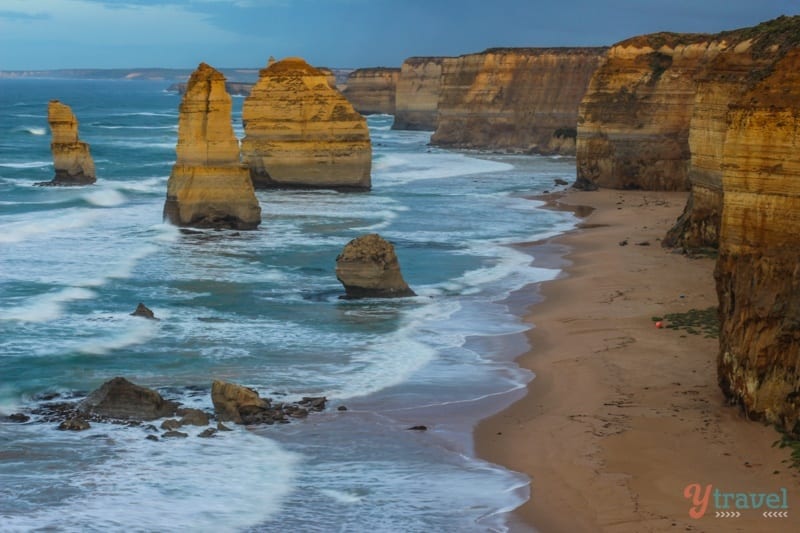
- Distance from last stop: next door
- Drive time: 0 minutes
Just a couple of rocks jutting out of the ocean. Really, what’s all the fuss? These were our initial thoughts when planning to visit the 12 Apostles on the Great Ocean Road.
But the 12 Apostles are the star of the show. We got lucky with the weather the morning we arrived and after all the hype and expectations I’m happy to say we were left awe-struck!
These massive limestone structures tower 45 metres above the ocean and were formed some 20 million years ago as the sea gradually eroded the soft craggy limestone cliffs.
There are only eight of the twelve apostles remaining (the rest have fallen) and forming the backdrop are these magnificent cliffs up to 70 metres high.
Tips for visiting the 12 Apostles
- Arrive at the 12 Apostles for sunrise – you’ll beat the tour buses and have the place almost to yourself.
- Enjoy a sunset with a picnic or we grabbed a takeaway pizza from Port Campbell.
- Walk the boardwalks around the cliff tops which provide various viewing platforms.
- Don’t rush. You may only witness this once in your life.
- Bring a tripod, use your camera’s self-timer and snap a family selfie.
Stop 16: Loch Ard Gorge
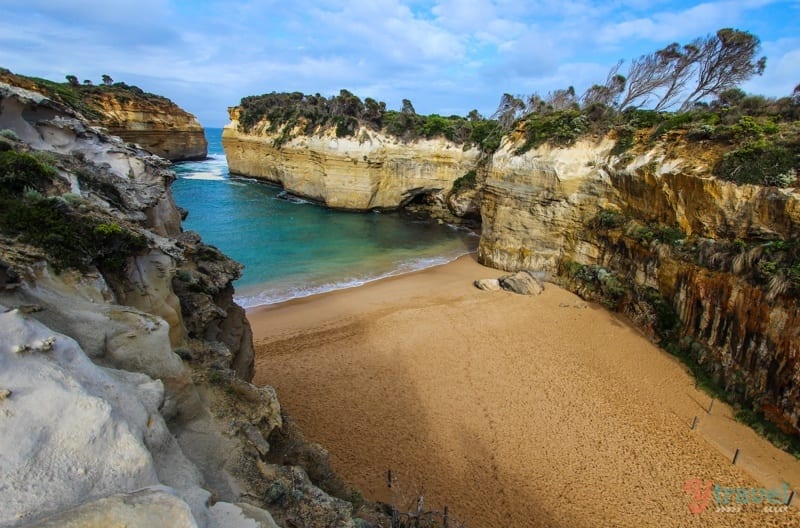
- Distance from last stop: 4.2 km
- Drive time: 5 minutes
Loch Ard Gorge is amazing and only a few minutes’ drive west of The Twelve Apostles. It was one of the most stunning beaches on the Great Ocean Road
Loch Ard Gorge is named after the ship Loch Ard, which ran aground on nearby Muttonbird Island at the end of a three-month journey from England to Melbourne.
Take the stairs down to the beach and sit in wonder. And there are three easy walks you can take to discover the area and get viewpoints.
Stop 17: The Arch
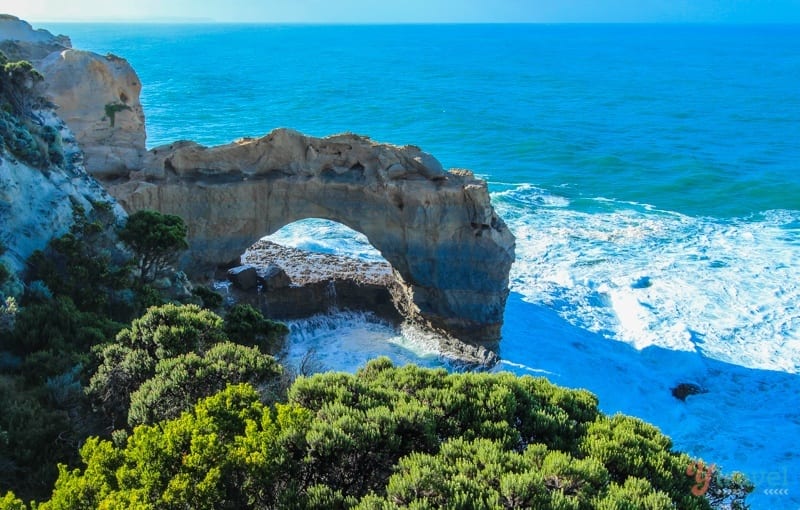
- Distance from last stop: 14.2 km
- Drive time: 14 minutes
This naturally sculptured arch stands 8 metres high and is located 6km west of Port Campbell.
You’ll appreciate the swells and power of the ocean crashing in against the arch, it makes the drama of the place even better.
Stop 18: London Arch (London Bridge)
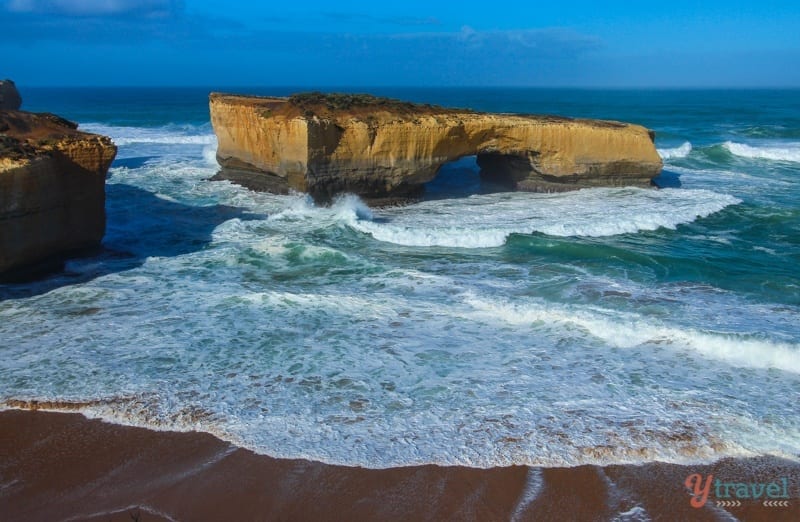
- Distance from last stop: 1.1 km
- Drive time: 3 minutes
London Arch was formed by a gradual process of erosion, and originally was a complete double-span and was attached to the mainland.
The arch closer to the shoreline collapsed unexpectedly in 1990 leaving two tourists stranded on the outer part until they were rescued by a helicopter. Ha. What a story to tell. We don’t recommend putting that in your Great Ocean Road itinerary.
Prior to the collapse, the arch was known as London Bridge because of its similarity to its namesake.
There are three separate viewing areas and the main path branches off to these at different intervals.
Stop 19: The Grotto
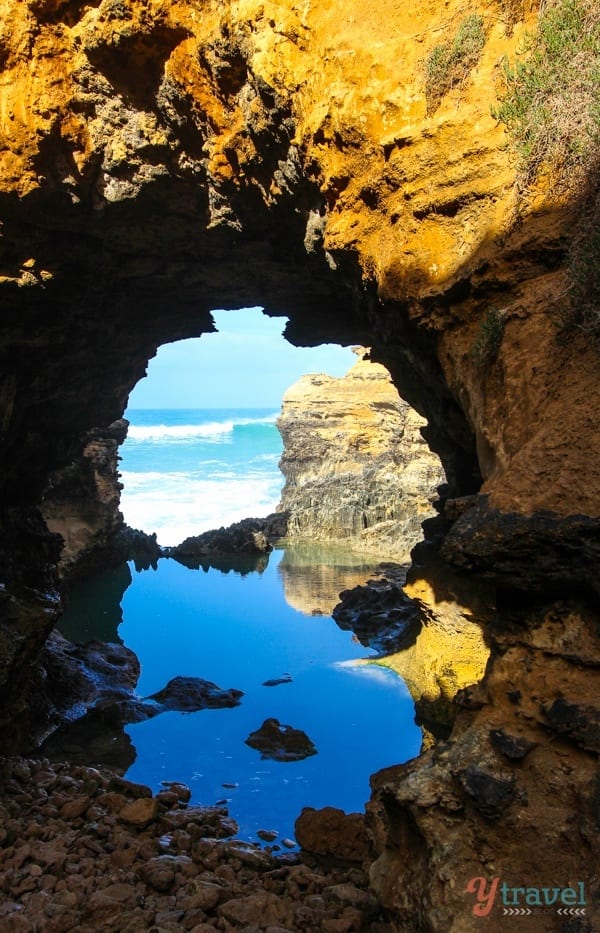
- Distance from last stop: 2.3 km
- Drive time: 4 minutes
The Grotto is basically a sinkhole. Take the steps down the cliff face to the bottom and look through and you’ll get visibility of the ocean beyond a pool at low tide.
It’s a pretty cool stop on your Great Ocean Road drive and has a cave-like quality to it.
Stop 20: Bay of Islands
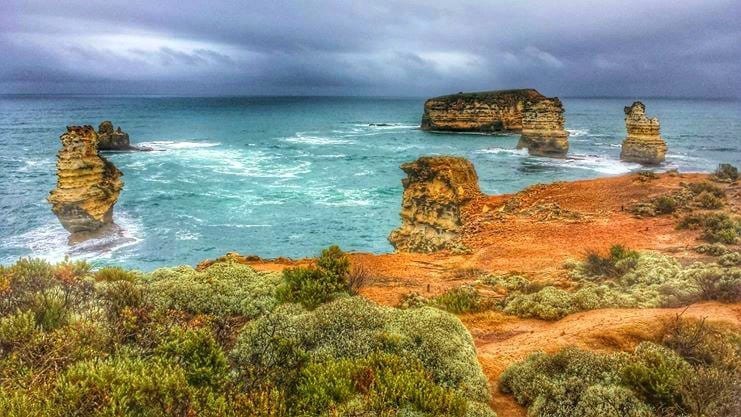
- Distance from last stop: 9.8 km
- Drive time: 10 minutes
The 12 Apostles are not the only magical rocks rising out from the ocean. Head a little further south to Peterborough and you’ll discover the mystical Bay of Islands and Bay of Martyrs.
Almost as beautiful, yet rarely talked about in a Great Ocean Road itinerary.
We didn’t get the nice weather we had at the 12 Apostles, but it adds to the drama.
Stop 21: Warrnambool

- Distance from last stop: 49.3 km
- Drive time: 39 minutes
The official end of the Great Ocean Road is Warrnambool, but don’t be in a hurry to rush back!
Warrnambool offers a mix of natural beauty and rich history. It’s renowned for its whale-watching opportunities from Logans Beach, where it’s possible to see southern right whales on their annual migration between June and September.
Be sure to visit The Flagstaff Hill Maritime Village for a glimpse into the 19th-century maritime history of the region and see findings from the shipwrecks along the infamous Shipwreck Coast.
Nature lovers should venture into Tower Hill Wildlife Reserve for a chance to see wild kangaroos and emus, as well as explore scenic hiking trails.
Tips for driving the Great Ocean Road
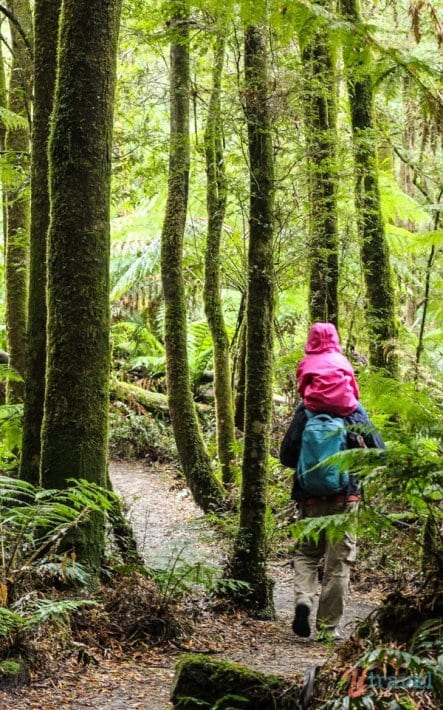
- Don’t do the Great Ocean Road drive in one day – Don’t just rush to the 12 Apostles for your tourist snap. Slow down and appreciate all it has to offer. Visit all the rock formations and towns, walk on a beach and in the rainforest, see a waterfall and native wildlife, sit on a lookout and be present. I would suggest 3 days minimum – we took 2 weeks!
- If you only have time to visit one section of the GOR, spend the most amount of your time in Port Campbell National Park.
- If you only drive in one direction, drive from Torquay to Warrnambool (East to West). That way you’ll be on the left side of the road closest to the southern ocean and you’ll be able to pull over easier to all the viewpoints.
- If you can drive, drive your own car, or rent a car from Melbourne instead of taking a Great Ocean Road tour. This road needs to be experienced from behind the wheel, and you need flexibility in where you stop and for how long. At each, turn you’ll discover something amazing.
- If you’re visiting in the winter months, keep your eyes peeled for whales!
- You may want to rent a unique caravan, motorhome, or camper to drive the Great Ocean Road. Outdoorsy is like the Airbnb of camper rentals, and they include insurance!
- Fuel up your car – there can be large distances between petrol stations, so make sure you fill up.
- If you do have to take an organized Great Ocean Road tour, we recommend these ones through Get your Guide.
Is the Great Ocean Road Worth Visiting?
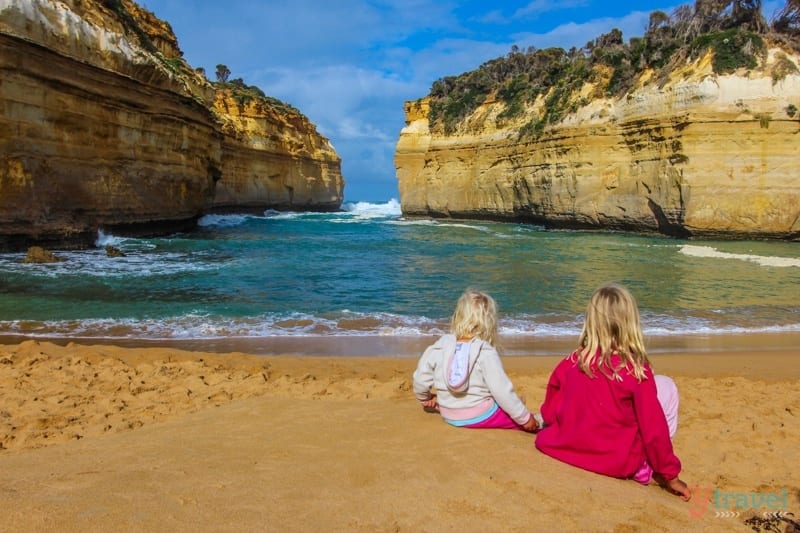
Is this even a question? It’s undeniably worth seeing the Great Ocean Road. Even if you are just planning on visiting Melbourne and only have a day to spend, it’s worth seeing at least some of it.
The road is most famous for its rock formations, which don the scenic coastal landscape. You will see stacks of limestone rock sitting comfortably off the shore – these are some of the most famous rock formations in the world.
Aside from that, you’ll pass by rural and quaint small towns and some truly unspoiled beaches. It’s always worth getting out of the city for some fresh air, and it doesn’t get fresher than this.
If anything else, it’s the most scenic way to travel between Melbourne and Adelaide.
Final Thoughts
So there you have it, those are the top things to do on the Great Ocean Road Australia, and as you can see, there is plenty of stops to add to your GOR adventure.
It really is a stunning coastal drive and we highly recommend you place it on your Australian travel bucket list.
Don’t rush it. It’s a beautiful drive and one that should be savoured like a fine wine. Take it slow, and enjoy the views, the peace, and the serenity.
Happy travels!
More Great Ocean Road Drive Tips
If you need more tips and inspiration for the drive, check out these other useful guides:
More Victoria Travel Tips
If you’re planning to travel to other parts of the state of Victoria in Australia, then you might like to read these guides:
Pin To Save It On Pinterest
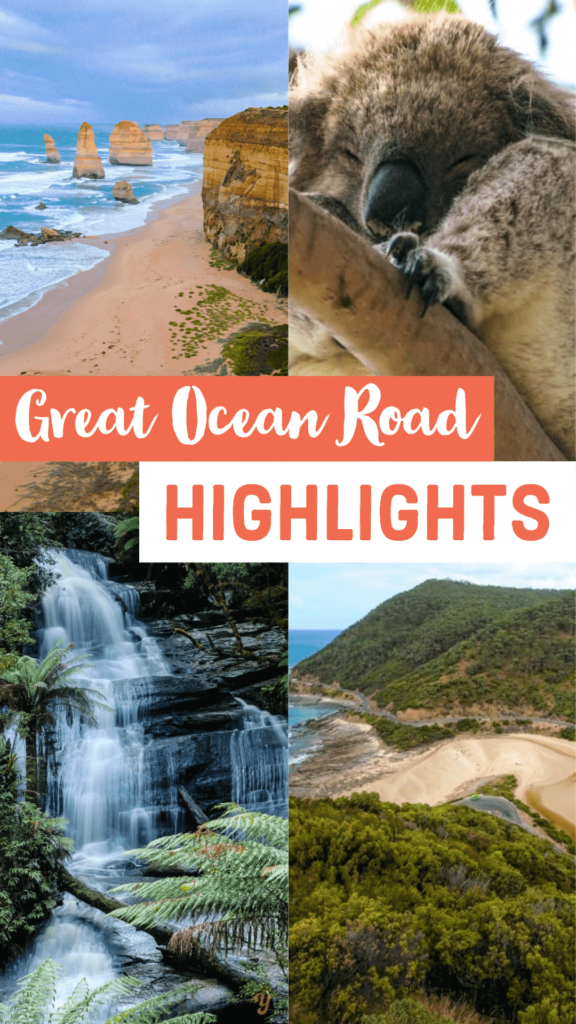
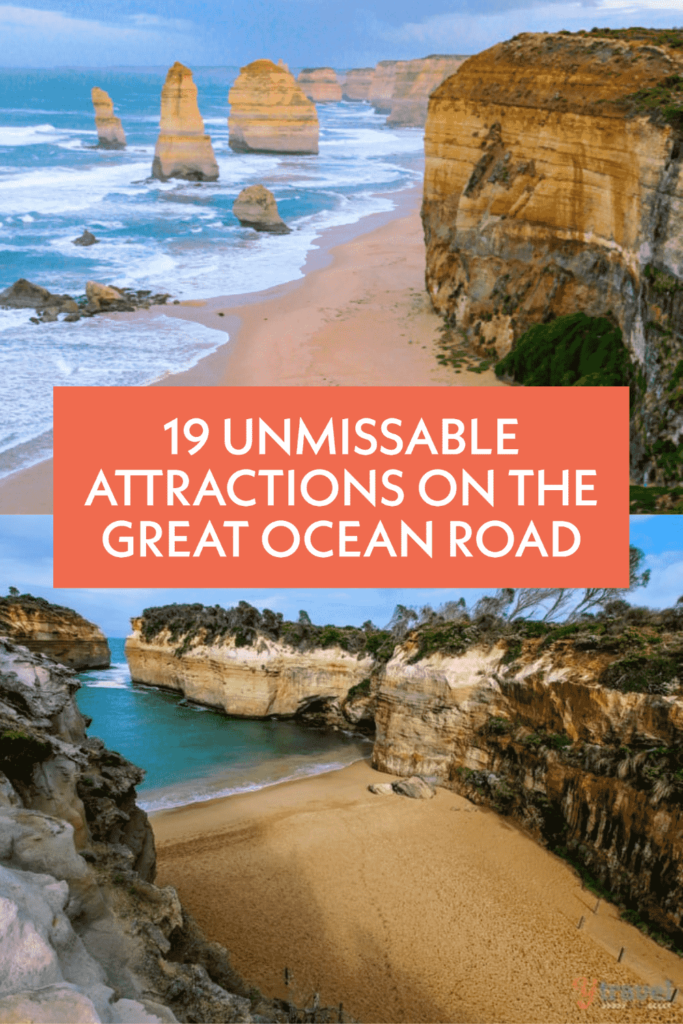
Are you planning on driving the Great Ocean Road? Let us know what you most want to see in the comments!


